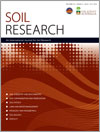SR13334Amending soil with sludge, manure, humic acid, orthophosphate and phytic acid: effects on aggregate stability
Effects of biosolids addition (composted manure and activated sludge) and spiking the soils with orthophosphate, phytic acid or humic acid, on soil aggregate stability of semi-arid loamy sand, loam and clay soils were tested before and after subjecting the soils to six consecutive rainstorms. Contribution of the amendments to pre- and post-rain aggregate stability was inconsistent. Relative to the control, stability of pre-rain aggregates was improved by all of the tested amendments while stability of the post-rain aggregates was improved by some amendments and deteriorated by others.




